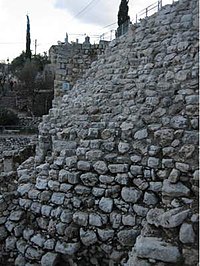| Siege of Jebus | ||||||||||
|---|---|---|---|---|---|---|---|---|---|---|
| Part of The Military campaigns of King David (1020 BC-965 BC) | ||||||||||
 Jebusite walls in the City of David, 2006 | ||||||||||
| ||||||||||
| Belligerents | ||||||||||
| United Kingdom of Israel | Jebusites | |||||||||
| Commanders and leaders | ||||||||||
| David | Unknown | |||||||||
| Strength | ||||||||||
| Unknown | Unknown | |||||||||
| Casualties and losses | ||||||||||
| Unknown | Unknown | |||||||||
The siege of Jebus is described in passages of the Hebrew Bible as having occurred when the Israelites, led by King David, besieged and conquered the Canaanite city of Jerusalem, then known as Jebus (Hebrew: יבוס, Yəḇūs, transl. 'threshing-floor'). The Israelites gained access to the city by conducting a surprise assault, and Jebus (or Jerusalem) was subsequently installed as the capital city of the United Kingdom of Israel under its initial name as the City of David.
The identification of Jebus with Jerusalem has been challenged. Danish biblical scholar Niels Peter Lemche notes that every non-biblical mention of Jerusalem found in the ancient Near East refers to the city with the name of Jerusalem, offering as an example the Amarna letters, which are dated to the 14th century BCE and refer to Jerusalem as Úrusalim. He states that "There is no evidence of Jebus and the Jebusites outside of the Old Testament. Some scholars reckon Jebus to be a different place from Jerusalem; other scholars prefer to see the name of Jebus as a kind of pseudo-ethnic name without any historical background".
Biblical description
The capture of Jebus is mentioned in 2 Samuel 5 and 1 Chronicles 11 with similar wordings:
And David and all Israel went to Jerusalem, that is, Jebus, where the Jebusites were, the inhabitants of the land. The inhabitants of Jebus said to David, "You will not come in here." Nevertheless, David took the stronghold of Zion, that is, the city of David.
— 1 Chronicles 11:4–5
Archeological evidence
A 10-years study with Carbon 14 confirmed that the City of David was the City of Jebus, in the south-east region of the odiern Jerusalem, which is the most ancient area of the Israel's capital.
See also
- Siege of Jerusalem (disambiguation), list of sieges for and battles of Jerusalem
References
- Lemche, Nies Peter (2010). The A to Z of Ancient Israel. Scarecrow Press. p. 161. ISBN 9780810875654. Retrieved 3 April 2020.
- Johanna Regev (2024-05-07). "Radiocarbon chronology of Iron Age Jerusalem reveals calibration offsets and architectural developments". Proceedings of the National Academy of Sciences. 121 (19). doi:10.1073/pnas.2321024121. PMC 11087761. Retrieved 2024-05-19.
This Bible-related article is a stub. You can help Misplaced Pages by expanding it. |
| The Bible and warfare | ||||||||||||
|---|---|---|---|---|---|---|---|---|---|---|---|---|
| Hebrew Bible battles |
|  | ||||||||||
| Bible Portal | ||||||||||||